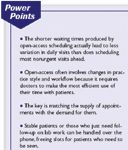Article
Don't be afraid of same-day scheduling
Even small practices have found it improves access for patients without being overwhelming for doctors.

Open access scheduling, also known as same day or advanced access scheduling, has not been widely adopted by small practices like Hamad's. Some physicians are afraid of being overwhelmed by demand if they offer appointments on the same day a patient calls. Others fear they'll have unused slots and nothing to do unless they schedule appointments far ahead.
But Sacramento based consultant and family physician Mark F. Murray, who pioneered open access 10 years ago, says these fears are misplaced. All practices have variations in demand, he notes, regardless of how they book visits. The shorter waiting times produced by open-access scheduling, he maintains, actually lead to less variation than does scheduling most nonurgent visits ahead.
That said, open-access scheduling does present some challenges. It often involves changes in practice style and workflow because it requires doctors to make the most efficient use of their time with patients. That means squeezing more into each patient visit, thereby reducing the number of visits each patient makes.
While prepaid arrangements reward efficiency, some fee-for-service physicians may think that reducing the number of unnecessary visits will penalize them financially.
Not so, says internist Neil A. Solomon, president of NAS Consulting in San Francisco. "By creating more space in the schedule, you can bring in new patients. And a new patient is a richer source of reimbursement for a similar level of need, compared with an existing patient. Also, by doing two things at the same time-addressing the chief complaint and doing preventive care in the same visit-you can often bill it out at a higher rate."
Here are the stories of three physicians who have implemented open access successfully. Two of them are in small practices, and the third works in a small clinic that's part of a larger group.
Starting a practice with open access C-Health, a small primary care group in Lebanon, VA, has offered same day access since it was co-founded by FP Brian T. Easton four years ago. Now comprised of four physicians and four midlevel practitioners in three sites, C-Health is a busy practice: At Easton's site, each of the two doctors has about 2,000 patients, and each of the two midlevels has 1,000 patients. Yet patients can get appointments whenever they want them.
The doctors take turns covering the office's evening and weekend hours, and they have some time off during the week. If Easton isn't in the office when one of his patients calls, he says, the patient can choose between seeing a midlevel immediately or visiting Easton the next day. "So it's up to the patient whether they want continuity of care or same day care. Ideally, they get both-that's true 80 percent of the time."
The key to doing open access, says Easton, is matching the supply of appointments with the demand for them. Physicians don't control the incidence of illness, but they do have some control over their follow-up visits. "For instance, when we schedule someone who comes in for a blood pressure check every 4 or 6 months, we try to steer away from the high-demand days like Monday and Tuesday."





